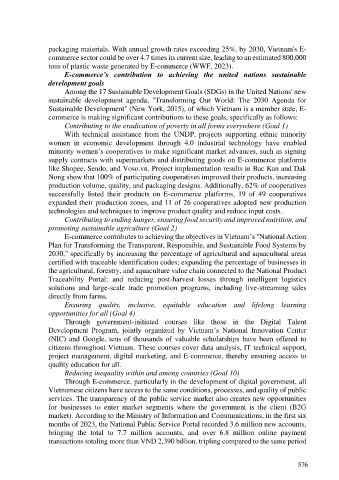Page 584 - Ebook HTKH 2024
P. 584
packaging materials. With annual growth rates exceeding 25%, by 2030, Vietnam's E-
commerce sector could be over 4.7 times its current size, leading to an estimated 800,000
tons of plastic waste generated by E-commerce (WWF, 2023).
E-commerce’s contribution to achieving the united nations sustainable
development goals
Among the 17 Sustainable Development Goals (SDGs) in the United Nations' new
sustainable development agenda, "Transforming Our World: The 2030 Agenda for
Sustainable Development" (New York, 2015), of which Vietnam is a member state, E-
commerce is making significant contributions to these goals, specifically as follows:
Contributing to the eradication of poverty in all forms everywhere (Goal 1)
With technical assistance from the UNDP, projects supporting ethnic minority
women in economic development through 4.0 industrial technology have enabled
minority women’s cooperatives to make significant market advances, such as signing
supply contracts with supermarkets and distributing goods on E-commerce platforms
like Shopee, Sendo, and Voso.vn. Project implementation results in Bac Kan and Dak
Nong show that 100% of participating cooperatives improved their products, increasing
production volume, quality, and packaging designs. Additionally, 62% of cooperatives
successfully listed their products on E-commerce platforms, 19 of 49 cooperatives
expanded their production zones, and 11 of 26 cooperatives adopted new production
technologies and techniques to improve product quality and reduce input costs.
Contributing to ending hunger, ensuring food security and improved nutrition, and
promoting sustainable agriculture (Goal 2)
E-commerce contributes to achieving the objectives in Vietnam’s "National Action
Plan for Transforming the Transparent, Responsible, and Sustainable Food Systems by
2030," specifically by increasing the percentage of agricultural and aquacultural areas
certified with traceable identification codes; expanding the percentage of businesses in
the agricultural, forestry, and aquaculture value chain connected to the National Product
Traceability Portal; and reducing post-harvest losses through intelligent logistics
solutions and large-scale trade promotion programs, including live-streaming sales
directly from farms.
Ensuring quality, inclusive, equitable education and lifelong learning
opportunities for all (Goal 4)
Through government-initiated courses like those in the Digital Talent
Development Program, jointly organized by Vietnam’s National Innovation Center
(NIC) and Google, tens of thousands of valuable scholarships have been offered to
citizens throughout Vietnam. These courses cover data analysis, IT technical support,
project management, digital marketing, and E-commerce, thereby ensuring access to
quality education for all.
Reducing inequality within and among countries (Goal 10)
Through E-commerce, particularly in the development of digital government, all
Vietnamese citizens have access to the same conditions, processes, and quality of public
services. The transparency of the public service market also creates new opportunities
for businesses to enter market segments where the government is the client (B2G
market). According to the Ministry of Information and Communications, in the first six
months of 2023, the National Public Service Portal recorded 3.6 million new accounts,
bringing the total to 7.7 million accounts, and over 6.8 million online payment
transactions totaling more than VND 2,390 billion, tripling compared to the same period
576

